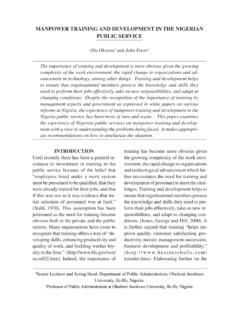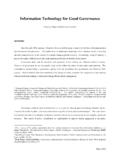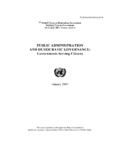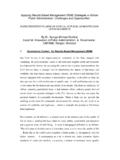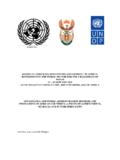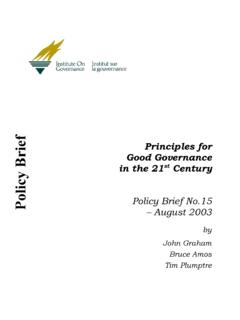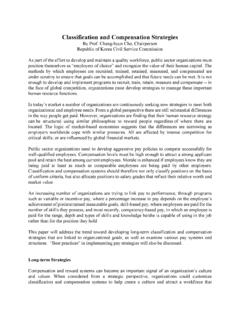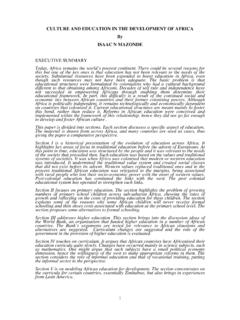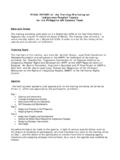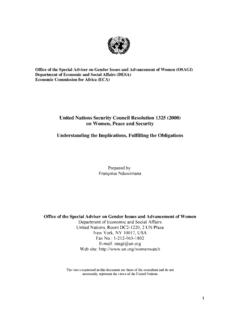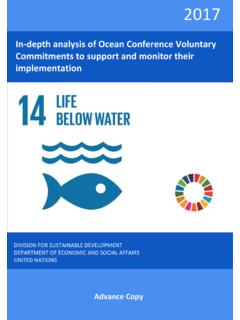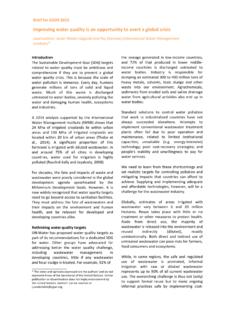Transcription of Leadership Styles - United Nations
1 Leadership StylesPresentation Introduction Basic Leadership Styles Other Leadership Styles ConclusionIntroduction A groom spent days in combing and rubbing down his horse, But stole oats and sold them for his own profit. Alas! said the Horse, If you really wish me to be in good condition, You should groom me less, And feed me more. Aesop's FablesOverview"What Leadership style work best for me and my organization?"There are many Leadership stylesfrom which to chooseDefining LeadershipFrom a very classical autocratic approach to a very creative, participative approachNot everything old was bad and not everything new was goodDifferent Styles were needed for different situations and each leader needed to know when to exhibit a particular approach Leadership strategies define every leader's personal Leadership styleMay adopt some of these in achieving the organization's goals and objectivesBasic Leadership stylesAutocratic Democratic Bureaucratic Laissez-faire Autocratic Leadership Style The classical approach Manager retains as much power and decision-making authority as possible Does not consult staff.
2 Nor allowed to give any input Staff expected to obey orders without receiving any explanations Structured set of rewards and punishments Greatly criticized during the past 30 years Gen X staff highly resistant Autocratic leaders: Rely on threats and punishment to influence staff Do not trust staff Do not allow for employee input Not all bad Sometimes the most effective style to use When: New, untrained staff do not know which tasks to perform or which procedures to follow Effective supervision provided only through detailed orders and instructions Staff do not respond to any other Leadership style Limited time in which to make a decision A manager s power challenged by staff Work needs to be coordinated with another department or organization Should not be used When.
3 Staff become tense, fearful, or resentful Staff expect their opinions heard Staff depend on their manager to make all their decisions Low staff morale, high turnover and absenteeism and work stoppage Bureaucratic Leadership Style Manages by the book Everything done according to procedure or policy If not covered by the book, referred to the next level above A police officer not a leader Enforces the rules Most effective When: Staff performing routine tasks over and over Staff need to understand certain standards or procedures. Safety or security training conducted Staff performing tasks that require handling cash Ineffective When: Work habits form that are hard to break, especially if they are no longer useful Staff lose their interest in their jobs and in their co-workers Staff do only what is expected of them and no more Democratic Leadership Style Also known as participative style Encourages staff to be a part of the decision making Keeps staff informed about everything that affects their work and shares decision making and problem solving responsibilitiesThe leaderA coach who has the final say, but gathers information from staff before making a decision Produce high quality and high quantity work for long periods of time Staff like the trust they receive and respond with cooperation, team spirit.
4 And high moraleThe democratic leaderDevelops plans to help staff evaluate their own performance Allows staff to establish goals Encourages staff to grow on the job and be promoted Recognizes and encourages achievement Not always appropriate Most successful when used with highly skilled or experienced staff or when implementing operational changes or resolving individual or group problems Most effective When: Wants to keep staff informed about matters that affect them. Wants staff to share in decision-making and problem-solving duties. Wants to provide opportunities for staff to develop a high sense of personal growth and job satisfaction. A large or complex problem that requires lots of input to solve Changes must be made or problems solved that affect staff Want to encourage team building and participationDemocratic Leadership should not be used when.
5 Not enough time to get everyone s input Easier and more cost-effective for the manager to make the decision Can t afford mistakes Manager feels threatened by this type of Leadership Staff safety is a critical concern Laissez-Faire Leadership Style Also known as the hands-off style The manager provides little or no direction and gives staff as much freedom as possible All authority or power given to the staff and they determine goals, make decisions, and resolve problems on their own An effective style to use .. Staff highly skilled, experienced, and educated Staff have pride in their work and the drive to do it successfully on their own Outside experts, such as staff specialists or consultants used Staff trustworthy and experienced Should not be used.
6 Staff feel insecure at the unavailability of a manager The manager cannot provide regular feedback to staff on how well they are doing Managers unable to thank staff for their good work The manager doesn t understand his or her responsibilities and hoping the staff cover for him or herOther Leadership StylesTransformational Leadership Creates and sustainsa context that maximizes human and organizational capabilities; Facilitatemultiple levels of transformation; and Alignthem with core values and a unified purposeTo respond to a dynamic environmentThe Transformational Leadership Make change happen in: Self, Others, Groups, and Organizations Charisma a special Leadership style commonly associated with transformational Leadership ; extremely powerful, extremely hard to teachTransactional Leadership Emphasizes getting things done within the umbrella of the status quo In opposition to transformational Leadership By the book" approach - the person works within the rules Commonly seen in large, bureaucratic organizationsCreative LeadershipAbility to uniquely inspirepeople,To complex and readily changing situations To generate shared innovative responses and solutionsCorrective LeadershipEmpowers staff to facilitate collaborative and synergismWorking with and through other people instead of bowing to authoritarianism Change Leadership Endorses alteration Beyond thinking about individuals and individual organization.
7 Single problems and single solutionsRethinking systems to introduce change on parts of the whole and their relationship to one another Intelligence LeadershipTo navigate the future by embracing ambiguity and reframing problems as opportunitiesA proactive stance in taking their organizations into uncharted territory Multicultural LeadershipFosters team and individual effectivenessDrives for innovation by leveraging multicultural differencesTeams work harder in an atmosphere of understanding and mutual respect Pedagogical LeadershipParadigm shift from leader/teacher centered "orientation" to an interactive, connective organizational system using a democratic learning and communicative styleAn alternative to instructional Leadership by enabling the learning and intellectual growth of those led Servant LeadershipA practical philosophy focusing on people who choose to serve first and then lead as a way of expanding serviceServant leaders are "servants first" with the object of making sure that other people's highest priority needs are being served Leaders put the needs of their followers first.
8 These leaders rare in businessBridging leadershipFostering synergy and reinforcing behavior and motivation through the use of communication to create climate of trust and confidenceProjection of confidence on the face of a difficult challenge Purposeful LeadershipLeader and the community share a common purpose to develop or provide the drive, authority and commitment to undertake projects ConclusionVarying Leadership Style Three factors that influence which Leadership style to use. manager s personal background: What personality, knowledge, values, ethics, and experiences does the manager have. What does he or she think will work? being supervised: Staff individuals with different personalities and backgrounds; The Leadership style used will vary depending upon the individual staff and what he or she will respond best organization: The traditions, values, philosophy, and concerns of the organization influence how a manager actsDetermining the Best Leadership Style Should leaders be more task or relationship (people) oriented Leaders have a dominant style, one they use in a wide variety of situations No one best style - leaders must adjust their Leadership style to the situation as well as to the people being led Many different aspects to being a great leader - a role requiring one to play many different Leadership Styles to be successful

